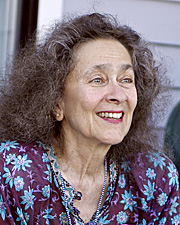Popeye’s dog made Selma Waldman inspired to become an artist and devote her life to art. Actually, it wasn’t the dog itself, but the man who created the dog, Selma’s uncle Myron Waldman, a renowned cartoonist who died just over a year ago.
Selma herself died of cancer on April 17. She was 77.
Waldman grew up in Texas, but moved to Seattle in 1957. Apart from a Fulbright scholarship in Berlin in 1959-60, she spent the rest of her life here.
Early on, her work hung in galleries alongside Georgia O’Keefe and Edward Hopper, but as her sympathies with the Civil Rights movement grew, she began to reflect her desire for justice in her art.
“She really believed in doing things in a way that she felt had integrity,” said Waldman’s son, Rainer Waldman Adkins. “She was very unswerving in her dedication to the artwork she was doing and to her activism for a better world.”
Phillip Levine, a local artist and longtime friend of Waldman’s, said that in addition to her excellent technical skills as a draftsperson and painter, particularly in her depiction of the human form, the themes of her work were also important.
“The content was intellectual and emotional and rational, and had to do with what the world is about,” Levine said. “It wasn’t decorative in a contemporary sense, in that you didn’t put it on your wall to enhance your environment, you put it on your wall to enhance your “˜view’ of the world.”
Waldman’s activism manifested itself in her Jewish identity, Adkins said.
“She believed that the experience Jews had had in the world gave a very powerful link to work for tikkun olam, for social justice and peace, and fighting oppression,” he said.
Though she considered herself a secular humanist and never belonged to a synagogue, “she had a very strong network in the grassroots of the Jewish community and really believed in the power and beauty of Jewish culture and experience,” Adkins said.
Waldman had considered making aliyah in the 1960s, but “that ended after the 1967 war and her growing awareness of the contradictions of Israel’s occupation of the West Bank and Gaza at the time,” Adkins said.
Her sympathy for the Palestinians made her some enemies within the Jewish community at the time, but it also helped to create circles of friends in the art and activist worlds that otherwise would never have connected. It also inspired her to create series of works against apartheid in South Africa, and she traveled to the country as a result.
“There [are] some of us, Selma particularly, that spoke out against the kinds of things that needed to be spoken out against,” Levine said. “She was good at this for several reasons: She was an extremely intelligent woman, well-read, and she was a superb writer.”
Waldman published eight books of drawings and documentation of abuses in Africa. Her Naked Aggression series, which has been exhibited in various galleries around the city, focused on that subject, as well as on the abuses at the Abu Ghraib prison in Iraq. She was also proud to be the only American artist to have works in the Jewish Museum in Berlin’s Holocaust collection; the pieces are several life-sized drawings of figures falling through space, from her Falling Man series.
Waldman was working until about two-and-a-half weeks before her death. Her son and family plan to start a foundation in her name to continue to bring recognition to her work. Selma Waldman is survived by her son, Rainer Waldman Adkins and his wife, Deb Figen; grandson Sam Adkins; and her sister Maryon Spotswood. A public memorial will be held June 1 at 5 p.m. at the Rainier Valley Cultural Center.
Selma Waldman
